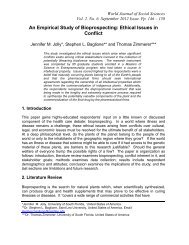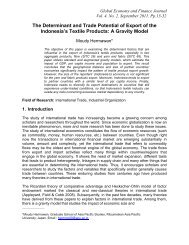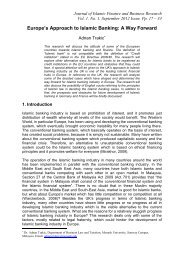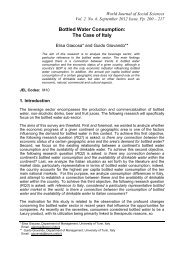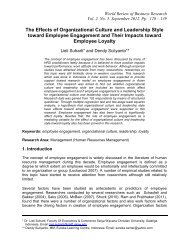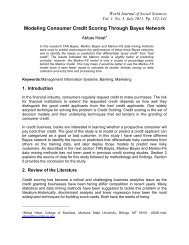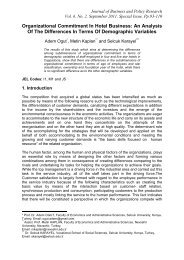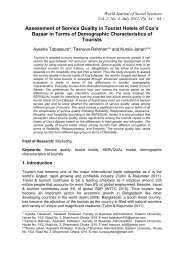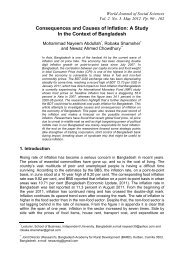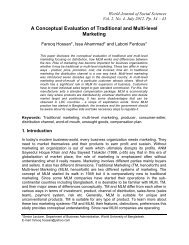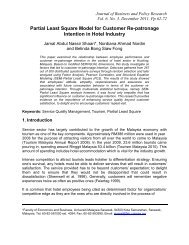PRICE OF CRUDE OIL: HOW IT IS FORMED FROM ... - Wbiaus.org
PRICE OF CRUDE OIL: HOW IT IS FORMED FROM ... - Wbiaus.org
PRICE OF CRUDE OIL: HOW IT IS FORMED FROM ... - Wbiaus.org
You also want an ePaper? Increase the reach of your titles
YUMPU automatically turns print PDFs into web optimized ePapers that Google loves.
World Journal of Social SciencesVol. 3. No. 1. January 2013 Issue. Pp. 109 – 118How Crude Oil Price is Formed: Exploration, Production,Refining and SaleMagsud Ibrahimov* and Rashid ZiyadliThe liberal market economy would not have reached today’s level without astrong incentive for development. During the last century the oil industryhas become the foothold fuelling market with oil commodities for tradingwhich turned out to be a highly demanded product as industrial revolutionproceeded into new phase requiring more energy. Oil as hydrocarbon isnot found everywhere and therefore its movement around the globebecame business with vast amount of financial flow. This paper isreviewing and assessing the price formation mechanism for crude oil. It isillustrated that the crude oil price is not reflecting either cost of productionor cost of refining, the speculative activity in this sphere of economyestablished unfair market conditions redirecting the price formation fromthe basic market principle based on supply and demand conception. It istherefore the task for world wide energy institutions, government bodiesand big business players to establish market with fair price for crude oilwhich is considering cost of production and further processing.Field of Research: Crude oil price formation on the basis of production and refiningcost1. IntroductionThe oil business is one of the biggest markets in the world where 160 countries areexecuting trading everyday. There are 45 crude oil exporting countries and 145importing this vital energy commodity (Smil 2005). The price of crude oil is the majordriver of GDP whereas it is calculated that 10 per cent adjustment of price of oil may atthe end lead to change in GDP between 2 to 6 per cents. It must also be underlined that66 per cent of world energy generation depends on crude oil and therefore pricefluctuation in this instance has tremendous importance for national governments and foreconomic performance overall (Movagharnejad 2011). The scale of significance of thisindustrial sector grows since the speculative activity in the market begins to impact onprice formation. It is demonstrated by Blas (2011) that interests for ‘put options’ (settingminimum sale price of crude oil) at price 45-60 US dollars rose in December 2011 by 33per cent as risk reduction measure taken by major market players in NYMEX.It is the fact that any price movement of oil has noteworthy impact on economicactivities whereas government subsidies in many countries directly impact on consumermarket and thus inflation, interest rate and unemployment. The empirical analysisprovided by Wu and Ni (2011) highlight direct connection between price of oil withmonetary policies of national governments setting interest rates which are reflected ininflationary pressure and rate of unemployment._________________*Magsud Ibrahimov. University of Liverpool. State Oil Company of Azerbaijan Republic Azadliq ave 16,apt 19. AZ1010, Baku, Azerbaijan. Tel: (+994 55 711 12 54). E-mail: magsudibrahimov@gmail.com
Ibrahimov & ZiyadliThis paper is reviewing and estimating impact of oil price fluctuations on economicindicators of countries with particular attention to GDP, inflation and unemployment rate.The analysis follows with study of cost formation of crude oil from the moment ofexploration and continues with indication of cost of refining process. This researchconcludes that oil price fluctuations are the result of trading activity at commodityexchanges directly putting financial burden on different economies both on exportingand importing crude oil countries. The price is impacting on major economic indicatorswhilst cost of oil production and refining has not been changing at the time when priceof oil fluctuated between 30 and 140 US dollars during financial crisis.2. Literature ReviewIt is basically recognized fact that the oil industry is to certain extent a balanced marketamong countries exporting crude oil and those that are importing it. According to latestresearch results studying reserve/production ratio, it is estimated that globally, there isenough oil for the next forty years whereas currently physical supply meets existingdemand (Spill 2011). On the basis of this conception, it is perceived that the price ofcrude oil and economies of different countries are reflecting the existing balance of themarket and therefore the price around 100 US dollars per barrel is believed to be truemarket price. According to some estimations the world’s largest crude oil exporter,Saudi Arabia, needs the price of oil to settle at level no less than 74 US dollars perbarrel so that to sustain economic growth and cover social programme obligation (Al-Rikabi 2011). However, there are very specific characteristics of the market whichshould also be taken into account before making conclusions regarding truthfulness ofthe price.As it is stated by Green (1976) even oil exporting countries which are taking advantageof high price must be divided into two categories. There must be made gradation forthose countries that are totally dependent on oil revenue for economic growth and thosewhich actually may allow themselves to release its dependence on petrodollars andtherefore countries such as Iran or Venezuela due to their political conditions aresometimes excluded from the list of reliable oil supplying countries. Meanwhile, it isargued that once these countries become more liberalized or in another words moremarket oriented the price of oil shall automatically fall since there will be morecompetition in the market. However, this analysis does not take into account such factas oil reserves that may bring into the market more than 2 million barrels per day andSaudi Arabia is playing the role of such reserve supplier in the market. During theshortage period of crude oil because of Syria uprising and Libyan civil war in 2011 and2012, Saudi Arabia was the only OPEC member that increased the production rate tocover the gap between of physical supply and demand in the market. It is worthmentioning that despite seemingly positive development tendency in Iraq, the absenceof oil law protecting investments and guaranteeing return of capital, the full scaleexpansion of the industry is limited due to lack of lawfully protective measures (TheEconomist 2009). Thus, the classification of two types crude oil export countries is notreflecting actual reality and balance of power in world oil market. First of all, countriessupplying crude are often making politically motivated decisions, oppose to liberalmarket economy principles. Secondly, there is enough oil to drop into the market toreduce price. Finally, political or military turbulences occurring in oil exporting countriessignificantly affect market in terms of supply. In the frame of analysis of economicsectors impacted by volatile crude oil prices, there shall be made research of effect on110
Ibrahimov & Ziyadlieconomic growth, unemployment and inflation rates. These there fundamental marketindicators are demonstrating the extent of impact of crude oil price movement oneconomies and businesses. It must be noticed that the higher this effect is estimated,the stronger would be the case for fundamental change in price formation of crude oil.3. MethodologyThe topic of examination is quite broad and there significant amount of academic workstudying the crude oil industry from different perspectives. There are three main areas(upstream, midstream and downstream) in this field which covers the process from thepoint of exploration and finishing the cycle with the sale of petroleum products to enduser. Although, there were some studies in each of these areas, there are only fewnumerical analyses in relation to price formation of oil and its derivates in the market.This paper is relying on empirical evidence highlighting the scheme of oil movement in acomplicated system of crude oil processing pointing out the price formation at everystage of the process. Oil price fluctuation studied by Ozbek and Ozlale (2010) concludethat the price formation and unpredictability of price movements is the reflection ofstochastic changes in the market. Furthermore, it is argued that neither demand for oilnor for petroleum products is actually driving market prices. The basis for this argumentlies in 2008-2010 sharp changes in the market when price fell down from 140 US dollarsto less than 30 US dollars per barrel whereas the demand for crude oil has not beenchanging. Following this basic conception, it is demonstrated and stressed in this paperthat price fluctuation in the market does not indeed based on cost-price relationshipmodel, the market reflects the price of oil which is the result of speculative trading. Themajor focus point of this study would be the economic performance of the US as trueindicator of impact of oil prices movement.4. Why Crude Oil Price is Important?Economic GrowthRising cost of energy sources and crude oil in particular puts great financial burden onconsumers through every service sector as all of them are energy dependant. In thisregard, it would be relevant to look through the US market where mounting price of oilraised the debt of the US from 1.7 per cent GDP in 1981 to 2.8 per cent by 2002 (Leeb& Leeb 2004). It is stated by Farlow (2005) that fiscal excess existed during pre-Bushperiod of 2.4 per cent of GDP in relatively short period of time turned to be 5 per centdeficit of GDP. This tendency might be observed in the US mortgage market wheredebts were rising at the time of economic stagnation period of the country. In thebeginning of 1970s the mortgage debts were estimated to be around 298 billion USdollars whereas in 2002 this number reached 6 trillion US dollars. It is shown by Leeband Leeb (2004) that the beginning of market decline from 2000 led to 7 trillion USdollars losses in housing market. One of the important characteristics of the US housingmarket is that buying house is not a simple purchase, it is an investment and thereforethe system, the business cycle, begins working from the moment of its sale. Wheninterest rate is low, the real estate is becoming more affordable keeping the market aliveassuming that economic growth would be secured. However, it is the fact that oncebuyers are not able to pay for their homes, the debts are began growing. All thesediscussions around real estate market are basically linked to energy market,import/export capabilities, tax regulations, etc. It is calculated that since 2006 the priceof real estate in the US fell by more than 36 per cent whereas 2.9 million houses111
Ibrahimov & Ziyadlireceived closure notices within 2011 alone. Furthermore, the rising energy cost meansthat householders shall be left with no option, but to cut its expenditures. Adding highrate of unemployment along with gloomy economic outlook of the US, it is predicted thatwith high oil prices real estate market does not have a potential for development neitherin short or mid-term future (Alden, 2011). Considering the fact that almost 5 per cent inGDP of the US consists of construction sector, it is not surprising that falling activity inthis segment of economy has led to decline GDP growth. According to FOMC (FederalOpen Market Committie) the GDP of the US fell from 4 percent growth in 2007 to minus1 per cent a year later (Economic Projection FOMC 2012). Thus, it should be noticedthat it was the rising price of oil to 140 US dollars per barrel in 2008 that haddevastating effect on GDP of the US through falling economic activity in housing andconstruction sector.UnemploymentThere were several very significant events within last several decades, two oil crises,establishment of OPEC, fall of USSR, etc. All these events had global and very strongimpact on economies, especially the US as major economic super power of the world.According to Uri (1996) there is direct linkage between oil price movement and risingunemployment rate throughout this period of time. However, this connection does notseem to be obvious as per quantitative analysis since the price of crude oil rose by 1,54per cent on annual basis unemployment rose only by 0.0078 per cent. Based on thisstand, it might also be concluded that falling oil price shall not lead to growth inunemployment rate. However, neither rapidly growing nor falling oil prices will stimulateeconomic growth and therefore unemployment shall go up as it was during financialcrises of 2008 when it increased from 4 per cent in 2007 to 10 per cent in 2010 in theUS (Economic Projection FOMC 2012). The same is observed in the EU where theunemployment rate stands now at its highest level for the last ten years of 10.4 per centof total labour force which equals to almost entire Holland population of 16.5 millionpeople (Pignal 2012). There is no clear evidence that level of unemployment directlydepends on crude oil price, however, it is the level of economic activity securing highemployment level. It is therefore vital in the first instance to sustain economic growth atthe time of fluctuating crude oil prices.InflationThis part analyzes the rising cost of living since it is stressed by Leeb and Leeb (2004)that the major effects of rising cost of oil is observed in inflation indicators. It is aconstant problem for all countries when prices are soaring up whereas this tendency inthe US is linked with rising energy and oil prices. It is believed that breakeven point forinflation rising at the rate of more than two per cent yearly, would be raising price of oilhigher than 89 US dollars per barrel (Mackienze 2012). The only positive effect fromfinancial crises of 2008 was constantly low rate of inflation observed in the US. Theinflation rate went down from 3 per cent in 2007 to 1,5 per cent by 2009 (EconomicProjection FOMC 2012) However, it should also be added that inflationary pressure isnot always associated with oil prices, rising prices in China standing at the level of 6.5per cent per annum, for example, is explained to be the result of food shortages ratherthan energy sector negative impact (Anderlini 2011). So, inflation is not direct result ofrising crude oil prices, although, it must be stressed that price of this commodityconsequently leads to rising price of dependant and related industries, such astransportation.112
Ibrahimov & Ziyadli7. ConclusionThe price of crude oil cost of production and final price of petroleum products havedramatic impact on living standards, expenditures and certainly to overall economicperformance. The changing price of crude oil has considerable effect on economicgrowth, unemployment and inflation rate. Whilst inflation rate is falling with decliningprice of oil in the market, increasing rate of unemployment does not have any direct linkwith oil price volatility in the market. Nevertheless, risk of economic growth isjeopardizing entire economic performance. Stagnation or economic downturn periodprovoked by high oil prices leads to growing unemployment as well as uncontrollableinflation rate putting pressure of monetary policy of the states.The analysis conducted in the sphere of crude oil exploration and production showedthat cost varies depending on place whereas the cheapest source is Middle Eastdeserts and the most expensive one is in Arctic region. It was highlighted that this costfluctuates between 40 and 100 US dollars per barrel. The calculation of cost of refiningon the basis of the US market figures for unleaded gasoline revealed that 5-10 per centof the price of petroleum products is the actual cost of refining. The case study showedthat this cost equals to 0.14 US cents per barrel whereas 71 per cent of the cost ofpetrol is formed on crude oil price. Table 1 presents actual petroleum price formation inthe market summarizing arguments that crude oil price is not reflecting production andrefining cost.2.81 USDprice pergallongasoline71% = 2.03oil cost 85.265% = 0.13barrelpricerefining costTable 1Convent Deepwater Arctic oiloil oil40 USD 60 USD 100USDDifference+45.26 and+25.26ave:35.26According to the figures presented in Table 1 summarizing arguments of this researchpaper, the crude oil is overpriced in the market by an average of 35.26 US dollars perbarrel. The sale price of crude oil is almost twice as much as the cost of production.Moreover, the refining cost keeps the lowest percentage in price formation of petroleumproducts. Thus, it must be drawn conclusion at this stage that cost of crude processingis not building price of oil. The existing price as well as its fluctuations therefore doesnot reflect changes in cost, it is the outcome of speculative trading activities.Whilst neither oil production nor refining cost changes significantly, the price fluctuationoccurring in crude oil seriously puts pressure on consumer market consequentlyincreasing risk of economic downturn. There is need for establishment of pricesettlement mechanism guided by various international institutions so that stabilizemarket as the market cost of price fluctuation is high since it is reducing economicincentives. The purchase price of crude therefore must be referring to production andrefining cost rather than speculative activity or the conception of ‘availability’ in themarket.116
Ibrahimov & ZiyadliReferencesAlden, W 2011, ‘Oil prices Raise Cost of Homeownership, Threatening HousingRecovery’, Huff Post Business. Viewed 16 March 2012,http://www.huffingtonpost.com/2011/03/08/oil-prices-housingmarket_n_832973.htmlAl-Rikabi, R & Smith, G 2011, ‘Oil Trades Near Two-Week High on Speculation U.S.Recovery to Boost Demand’, Bloomberg. Viewed 16 March 2012,http://www.bloomberg.com/news/2011-12-26/oil-futures-open-at-99-92-a-barrel-24-cents-higher-in-new-york-trading.htmlAnderlini, J 2011, ‘China Acts After Inflation Rises’, Financial Times. Viewed 16 March2012, http://www.ft.com/intl/cms/s/0/69aa5fcc-670d-11e0-8d88-00144feab49a.html#axzz1p7Wzskf5Blas, J 2011, ‘IEA Urges OPEC to Maintain Supplies’, Financial Times, viewed 16March 2012, http://www.ft.com/intl/cms/s/0/714eb786-2568-11e1-9c76-00144feabdc0.html#axzz1p7Wzskf5Chang, Y and Wong, JF 2003, ‘Oil price Fluctuations and Singapore Economy’, EnergyPolicy, vol. 31. pp. 1151-1165Cohen, K 2011, ‘Gas Prices and Industry Earnings: A few Things to Think About theNext Time You Full Up’, ExxonMobil Perspectives, Viewed 16 March 2012,http://www.exxonmobilperspectives.com/2011/04/27/gas-prices-and-industryearnings-a-few-things-to-think-about/.Deffeyes, KS 2009, Hubbert’s Peak: The Impeding World Oil Shortage, Oxfordshire,Princeton University PressDowney, M 2009, Oil 101. New York, Wooden Table PressEuropean Environmental Agency 2012, ‘Cost of Oil Production: Production CostComparison Between arctic Oil, Deep and Ultra-Deepwater Oil, Heavy Oil andBitumen, Conventional Oil’, European Environment Agency, Viewed 16 March2012 http://www.eea.europa.eu/data-and-maps/figures/cost-of-oil-production.Energy Almanac 2012, ‘Estimated 2012 Gasoline Price Breakdown and MarginsDetails’, The California Energy Commission, Viewed 16 March 2012,http://energyalmanac.ca.gov/gasoline/margins/index.php.Farlow, A 2005, ‘UK House Prices, Consumption and GDP, in a Global Context’, TheEconomist, Viewed 16 March 2012,http://www.economics.ox.ac.uk/members/andrew.farlow/Farlow%20Housing%20and%20Consumption.pdf.Federal Open Market Committee 2012, ‘Economic Projections of Federal ReserveBoard Members and Federal Reserve Bank Presidents’, The Federal Reserve,Viewed 16 March 2012,http://www.federalreserve.gov/monetarypolicy/files/fomcprojtabl20120125.pdf.Green, EA 1976, ‘Can Expanded Exploration Lower Oil Prices?’, Energy, vol. 1. pp. 25-32.Leeb, S & Leeb, D 2004, The Oil Factor: Protect Yourself From Coming Energy Crises.New York, Warner Business Books.Lima, RS & Schaeffer, R 2011, ‘The Energy Efficiency of Crude Oil Refining in Brazil: ABrazilian Refinery Plant Case’, Energy, vol. 36. pp. 3101-3112.Mackenzie, M 2012, ‘Oil Fears Hit US inflation Expectations’, Financial Times, viewed16 March 2012, http://www.ft.com/intl/cms/s/0/08a3d6dc-621a-11e1-807f-00144feabdc0.html#axzz1p7Wzskf5.117
Ibrahimov & ZiyadliMovagharnejad, K, Mehdizadeh, B, et al. 2011, ‘Forecasting the Differences BetweenVarious Commercial Oil Prices in the Persian Gulf Region by Neural Network’,Energy, vol. 36. pp. 3979-3984.Ozbek, L & Ozlale, U 2010, ‘Analysis of Real Oil Prices Via Trend-CycleDecomposition’, Energy Policy, vol. 38. pp. 3676-3683.Peel, M 2011, ‘Saudi Arabia Halts $100bn Oil Expansion Programme’, Financial Times,viewed 16 March 2012, http://www.ft.com/intl/cms/s/0/967a332a-146d-11e1-8367-00144feabdc0.html.Peterson, DJ & Mahnovski, S. 2003, New Forces at Work in Refining: Industry Views ofCritical Business and Operations Trend, Pittsburgh, Rand.Pignal, S 2012, ‘Eurozone Jobless Rate At Euro-Era High’, Financial Times, viewed 16March 2012, http://www.ft.com/intl/cms/s/0/dca5fe48-4bf3-11e1-98dd-00144feabdc0.html#axzz1p7Wzskf5.Smil, V 2011, Oil. Oxford, OneworldSzklo, A & Schaeffer, R 2007, ‘Fuel Specification, Energy Consumption and CO2Emission in Oil Refineries’, Energy, vol. 32, pp. 1075-1092Tavarez, ME, Szklo, A, et al 2006, ‘Oil Refining Expansion Criteria for Brazil’, EnergyPolicy, vol. 34, pp. 3027-3040The Economist 1997, ‘Oil Refining: Grease is Good’, The Economist, viewed 16 March2012, http://www.economist.com/node/149726.The Economist 2009, ‘Iraq’s Oil: Crude Calculations’, The Economist, viewed 16 March2012, http://www.economist.com/node/15099516.The Economist 2010, ‘Over a Barrel: Brazil’s Oil Giant May be Paying Too Much topump the Stuff’, The Economist, viewed 16 March 2012,http://www.economist.com/node/16945222.The Economist 2011, ‘Oil Production and Consumption: Running Dry’, The Economist,viewed 16 March 2012, http://www.economist.com/blogs/dailychart/2011/06/oilproduction-and-consumption.The Economist 2011a, ‘Oil Reserves’, The Economist, viewed 16 March 2012,http://www.economist.com/node/18805887.The Economist 2011b, ‘Oil Prices: Speculators Unburned’, The Economist, viewed 16March 2012, http://www.economist.com/blogs/freeexchange/2011/07/oil-prices.The Economist 2011c, ‘Oil Prices: Trading Away Cheaper Petrol’, The Economist,viewed 16 March 2012,http://www.economist.com/blogs/freeexchange/2011/07/oil-prices-0.Uri, ND 1996, ‘Crude Oil Price Volatility and Unemployment in the United States’,Energy, vol 21. no 1. pp. 29-38.Vestifinance 2012, ‘The production of oil in Europe’, Vesti Finance, viewed 16 March2012 http://www.vestifinance.ru/infographics/690.Vestifinance 2012a, ‘The Impact of Speculators on Brent Oil Price’, Vesti Finance,viewed 16 March 2012, http://www.vestifinance.ru/infographics/680.Wu, M-H & Ni, Y-S 2011, ‘The Effects of Oil Prices on Inflation, Interest Rates andMoney’, Energy, vol. 36. pp. 4158-4164.118



